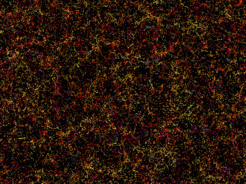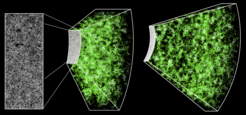1.2 Million Galaxies in 3D

This is one slice through the map of the large-scale structure of the Universe from the Sloan Digital Sky Survey and its Baryon Oscillation Spectroscopic Survey. Each dot in this picture indicates the position of a galaxy 6 billion years into the past. The image covers about 1/20th of the sky, a slice of the Universe 6 billion light-years wide, 4.5 billion light-years high, and 500 million light-years thick. Colour indicates distance from Earth, ranging from yellow on the near side of the slice to purple on the far side. Galaxies are highly clustered, revealing superclusters and voids whose presence is seeded in the first fraction of a second after the Big Bang. This image contains 48,741 galaxies, about 3% of the full survey dataset. Grey patches are small regions without survey data.
"We have spent a decade collecting measurements of 1.2 million galaxies over one quarter of the sky to map out the structure of the Universe over a volume of 650 cubic billion light years,” says Dr. Jeremy Tinker of New York University, a co-leader of the scientific team that led this effort. Hundreds of scientists are part of the Sloan Digital Sky Survey III (SDSS-III) team.
These new measurements were carried out by the Baryon Oscillation Spectroscopic Survey (BOSS) programme of SDSS-III. Shaped by a continuous tug-of-war between dark matter and dark energy, the map revealed by BOSS allows astronomers to measure the expansion rate of the Universe by determining the size of the so-called baryonic acoustic oscillations (BAO) in the three-dimensional distribution of galaxies.
Pressure waves travelled through the young Universe up to when it was only 400,000 years old at which point they became frozen in the matter distribution of the Universe. The end result is that galaxies are preferentially separated by a characteristic distance, which astronomers call the BAO scale. The primordial size of the BAO scale is exquisitely determined from observations of the cosmic microwave background.

This is a section of the three-dimensional map constructed by BOSS. The rectangle on the left shows a cut-out of 1000 sq. degrees in the sky containing nearly 120,000 galaxies, or roughly 10% of the total survey. The spectroscopic measurements of each galaxy - every dot in that cut-out - transform the two-dimensional picture into a three-dimensional map, extending our view out to 7 billion years in the past. The brighter regions in this map correspond to the regions of the Universe with more galaxies and therefore more dark matter. The extra matter in those regions creates an excess gravitational pull, which makes the map a test of Einstein’s theory of gravity.
Dr. Ariel Sanchez of the Max-Planck Institute of Extraterrestrial Physics (MPE) led the effort to estimate the exact amount of dark matter and dark energy based on the BOSS data and explains: "Measuring the acoustic scale across cosmic history gives a direct ruler with which to measure the Universe’s expansion rate. With BOSS, we have traced the BAO’s subtle imprint on the distribution of galaxies spanning a range of time from 2 to 7 billion years ago."
For the very precise measurements, however, the data had to be painstakingly analysed. Especially the determination of distances to the galaxies posed a big challenge. This is inferred from the galaxy spectra, which show that a galaxy’s light is shifted to the red part of the spectrum because it moves away from us. This so-called redshift is correlated with a galaxy’s distance: The farther a galaxy is away from us, the faster it moves.
“However, galaxies also have peculiar motions and the peculiar velocity component along the line-of-sight leads to the so-called redshift space distortion,” explains Dr. Shun Saito from the Max Planck Institute for Astrophysics (MPA), who contributed sophisticated models to the BOSS data analysis. “This makes the galaxy distribution anisotropic because the line-of-sight direction is now special – only along this direction the distance is measured through a redshift, which is contaminated by peculiar velocity. In other words, the characteristic anisotropic pattern allows us to measure the peculiar velocity of galaxies – and because the motion of galaxies is governed by gravity, we can use this measurement to constrain to what level Einstein’s general relativity is correct at cosmological scales. In order to properly interpret the data, we have developed a refined model to describe the galaxy distribution.”
Another approach, used by a junior MPE researcher for his PhD thesis, is to use the angular positions of galaxies on the sky instead of physical 3D positions. “This method uses only observables,” explains Dr. Salvador Salazar. “We make no prior assumptions about the cosmological model.”
Around the world, other groups all used slightly different models and methodologies to analyse the huge BOSS data set. “We now have seven measurements, which are slightly different, but highly correlated,” Ariel Sanchez points out. “To extract the most information about the cosmological parameters, we had to find not only the best methods and models for data analysis but also the optimal combination of these measurements.”
This analysis has now born fruit: the BOSS data show that dark energy, which is driving the cosmological expansion, is consistent with a cosmological constant within an error of only 5%. This constant, called Lambda, was introduced by Albert Einstein to counter the attractive force of matter, i.e. it has a repellent effect. Moreover, all results are fully consistent with the standard cosmological model, giving further strength to this still relatively young theory.
In particular, the map also reveals the distinctive signature of the coherent movement of galaxies toward regions of the Universe with more matter, due to the attractive force of gravity. Crucially, the observed amount of infall matches well to the predictions of general relativity. This supports the idea that the acceleration of the expansion rate is driven by a phenomenon at the largest cosmic scales, such as dark energy, rather than a breakdown of our gravitational theory.













